Assessment of Ecological Flow in Hulan River Basin Utilizing SWAT Model and Diverse Hydrological Approaches
Abstract
1. Introduction
| Study Area | Method | Research Focus | References |
|---|---|---|---|
| Taohe River | Runoff component investigation method | Identified runoff variation characteristics, highlighting the impact of current runoff calculations on ecological flow strategies. | [18] |
| Fenhe River | SWAT model and Tennant method | Explored ecological water supplement strategies, utilizing SWAT Model for effective water management. | [19] |
| Xibei River | Improved annual distribution method | Analyzed river ecological flow using an enhanced distribution approach, offering insights into water allocation and conservation. | [12] |
| Xishui River | Runoff component investigation method and SWAT model | Assessed water resources through integrated runoff investigation and modeling, facilitating comprehensive water resource management. | [20] |
| Hanjiang River | SWAT model and cellular automata | Examined the evolution of ecological flow characteristics under environmental changes, emphasizing adaptive management strategies. | [4] |
| Yellow River | Mann–Kendall test and double cumulative curve method | Investigated natural runoff reduction and consistency treatment methods, proposing solutions for sustainable river basin management. | [21] |
| Hei River | Heuristic segmentation method and various hydrological methods | Evaluated minimum and suitable ecological flows, considering hydrological variability for inland basin sustainability. | [22] |
| Yichang Section of Yangtze River | DFM and various hydrological methods | Determined ecological water requirements, leveraging DFM for ecological balance. | [23] |
| Long River | Physical habitat simulation and Penman–Monteith equation | Conducted quantitative ecological flow calculations, advocating for nature-based solutions in water resource optimization. | [24] |
2. Data and Methods
2.1. Data Source and Processing
2.1.1. Digital Elevation Model (DEM)
2.1.2. Meteorological Data
2.1.3. Hydrological Data
2.1.4. Land Use
2.1.5. Soil Type
2.2. Land Use Dynamic Degree (LUD) Index
2.3. Land Use Transfer Matrix
2.4. SWAT Model
2.5. Itemized Survey Method
2.6. Runoff Simulation and the Division of Flood and Drought Periods in Watershed
2.7. Ecological Flow Calculation
2.7.1. Distribution Method
2.7.2. Monthly Minimum Method
2.7.3. The Texas Method
2.7.4. Q50–Q90
2.7.5. The Tessman Method
2.7.6. The DFM Method
2.7.7. Northern Great Plains Resources Program (NGPRP)
2.7.8. Tennant Method
2.8. Quantification of Ecological Water Replenishment
3. Results and Analysis
3.1. Land Use Change Analysis
3.2. Results of Runoff Simulation and Watershed Division
3.3. Runoff Status Assessment
3.4. The Optimization of the Ecological Flow Calculation
3.4.1. Calculation Method Selection of Minimum Ecological Flow
3.4.2. Calculation Method Selection of Maximum Ecological Flow
3.5. Quantification of Ecological Water Replenishment
4. Discussion
4.1. Land Use Transfer Analysis
4.2. SWAT Model Building and Parameter Sensitivity Analysis
4.3. Natural Flow Restoration
4.4. Ecological Water Requirement Calculation
4.5. Methods Advantages and Limitations
5. Conclusions
- The land use change observed in Hulan River Basin between 2000 and 2010 demonstrated a significant transformation, highlighted by an increase in arable land and a considerable decrease in forested areas.
- In the evaluation of the minimum ecological flow, DFM yields slightly higher results in comparison to other methodologies. While both the variable Q90 method and DFM (Q2) method achieve a 10% match with the natural river flow, DFM exhibits a marginally lower level of adherence to hydrological patterns compared to the variable Q90 method.
- In the assessment of the optimal ecological flow for Hulan River Basin, it has been noted that different hydrological approaches produce comparable outcomes. However, only DFM has the capability to quantify the threshold of the optimal ecological flow. Furthermore, it is worth noting that the majority of results derived from alternative hydrological methods align with this threshold. Therefore, it is considered more suitable to utilize DFM for determining the ecological flow of Hulan River Basin.
- The utilization of the SWAT model to simulate the natural runoff dynamics of Hulan River has demonstrated a significant decrease in the resources needed for reinstating natural runoff, in contrast to traditional approaches to allocation and restoration. This approach involves reduced and simplified data requirements, yet it is also able to fulfill the stringent requirements set by DFM for hydrological data.
- The SWAT model is utilized to evaluate ecological flow and ecological water scarcity throughout the watershed, taking into account the hydraulic interconnections among sub-watersheds. This methodology enables the assessment of the spatiotemporal distribution of ecological flow and water scarcity in the watershed. Consequently, it facilitates a more intuitive and rational spatial allocation of water resources to fulfill the overarching ecological flow requirements.
Author Contributions
Funding
Institutional Review Board Statement
Informed Consent Statement
Data Availability Statement
Conflicts of Interest
References
- Wu, M.; Chen, A.; Zhang, X.N.; McClain, M.E. A Comment on Chinese Policies to Avoid Negative Impacts on River Ecosystems by Hydropower Projects. Water 2020, 12, 869. [Google Scholar] [CrossRef]
- Wang, Y.; Li, X.M.; Zhang, F.; Wang, W.W.; Xiao, R.B. Effects of Rapid Urbanization on Ecological Functional Vulnerability of the Land System in Wuhan, China: A Flow and Stock Perspective. J. Clean. Prod. 2020, 248, 119284. [Google Scholar] [CrossRef]
- Wang, F.Y.; Tong, S.; Chu, Y.; Liu, T.L.; Ji, X. Spatio-Temporal Evolution of Key Areas of Territorial Ecological Restoration in Resource-Exhausted Cities: A Case Study of Jiawang District, China. Land 2023, 12, 1733. [Google Scholar] [CrossRef]
- Li, Z.; Huang, B.; Qiu, J.; I, Y.; Yang, Z.; Chen, S. Analysis on evolution characteristics of ecological flow of Hanjiang River under changing environment. Water Resour. Prot. 2021, 37, 22–29. [Google Scholar]
- Li, Y.; Sun, C.; Liu, H. Supervision of river ecological flow and verification of control objectives in Fujian Province. Water Resour. Prot. 2020, 36, 92–96+104. [Google Scholar]
- Huang, S.Z.; Chang, J.X.; Huang, Q.; Wang, Y.M.; Chen, Y.T. Calculation of the Instream Ecological Flow of the Wei River Based on Hydrological Variation. J. Appl. Math. 2014, 2014, 127067. [Google Scholar] [CrossRef]
- SL/T 712-2021; Specification for Calculation of Ecological Flow for Rivers and Lakes. 2021. Available online: https://www.nssi.org.cn/nssi/front/114226640.html (accessed on 11 March 2024).
- Tang, Q.C. Water resources and oasis construction in Tarim Basin. Resour. Sci. 1989, 6, 28–34. [Google Scholar]
- Meng, Y.; Xu, W.J.; Guan, X.J.; Guo, M.; Wang, X.R.; Yan, D.H. Ecology-Habitat-Flow Modular Simulation Model for the Recommendation of River Ecological Flow Combination. Environ. Model. Softw. 2023, 169, 105823. [Google Scholar] [CrossRef]
- Zheng, Y.W.; Yang, T.; Wang, N.; Wan, X.H.; Hu, C.T.; Sun, L.K.; Yan, X.R. Quantifying Hydrological-Ecological Response Relationships Based on Zooplankton Index of Biotic Integrity and Comprehensive Habitat Quality Index—A Case Study of Typical Rivers in Xi’an, China. Sci. Total Environ. 2023, 858, 159925. [Google Scholar] [CrossRef]
- Wang, B.; Cheng, H.; He, X.J.; Xu, Y.P.; Guo, Y.X.; Geng, F.; Wang, C. Study on Early Warning and Forecasting Model of Ecological Flow in Rivers and Lakes Based on LSTM Deep Learning. J. China Hydrol. 2023, 43, 65–70. [Google Scholar]
- Tian, X.R.; Jiang, N.; Shi, Q.; Li, D.L.; Ni, P.; Liu, Y.; Wang, X.X. Study on River Ecological Flow Based on Improved Annual Distribution Method. Water Sav. Irrig. 2022, 10, 31–36. [Google Scholar]
- Yu, S.; He, L.; Lu, H.W. A Tempo-Spatial-Distributed Multi-Objective Decision-Making Model for Ecological Restoration Management of Water-Deficient Rivers. J. Hydrol. 2016, 542, 860–874. [Google Scholar] [CrossRef]
- Yu, S.; Wang, M.Y. Comprehensive Evaluation of Scenario Schemes for Multi-Objective Decision-Making in River Ecological Restoration by Artificially Recharging River. Water Resour. Manag. 2014, 28, 5555–5571. [Google Scholar] [CrossRef]
- Kal, B.-S.; Cho, S.-H.; Park, C.-D.; Mun, H.-S.; Joo, Y.-E.; Park, J.-B. Watershed Water Quality Management Plan Using Swat and Load Duration Curve. J. Korean Assoc. Geogr. Inf. Stud. 2021, 24, 41–57. [Google Scholar]
- Liu, Y.; Li, H.Y.; Cui, G.; Cao, Y.Q. Water Quality Attribution and Simulation of Non-Point Source Pollution Load Flux in the Hulan River Basin. Sci. Rep. 2020, 10, 1941. [Google Scholar] [CrossRef]
- Cui, G.N.; Bai, X.Y.; Wang, P.F.; Wang, H.T.; Wang, S.Y.; Dong, L.M. Agricultural Structures Management Based on Nonpoint Source Pollution Control in Typical Fuel Ethanol Raw Material Planting Area. Sustainability 2022, 14, 7995. [Google Scholar] [CrossRef]
- Niu, Z.R.; Wang, Q.Y.; Sun, D.Y.; Zhang, R.; Wu, X.; Xing, Y.P.; Zhan, S.J. Runoff variation characteristics of Taohe River Basin based on calculation of current runoff. Arid Land Geogr. 2021, 44, 149–157. [Google Scholar]
- Yang, R.; Feng, M.Q.; Sun, X.P.; Yang, Z. Calculation Method of Environmental Flow in the Middle Reaches of Fenhe River Based on Improved Tennant Method. Water Resour. Power 2018, 36, 13–15. [Google Scholar]
- Wang, Y.X.; Hu, T.S.; Wang, J.L.; Wu, F.Y.; Wang, X. Approach for water resources assessment based on runoff component investigation method and SWAT model. J. Water Resour. Water Eng. 2023, 34, 54–65. [Google Scholar]
- Jia, S.F.; Liang, Y.; Zhang, S.F. Discussion on evaluation of natural runoff in the Yellow River Basin. Water Resour. Prot. 2022, 38, 33–38+55. [Google Scholar]
- Liu, Y.; Cui, G.; Li, H.Y. Optimization and Application of Snow Melting Modules in Swat Model for the Alpine Regions of Northern China. Water 2020, 12, 636. [Google Scholar] [CrossRef]
- Jing, M.Y.; Wang, L.Q.; Chu, L.L.; Li, T.N. Research on the Ecological Flow of the Mainstream of the Hulan River Based on the Improved River2D Model. China Rural Water Hydropower 2023, 3, 102–110+119. [Google Scholar]
- Wu, M.; Chen, A. Practice on Ecological Flow and Adaptive Management of Hydropower Engineering Projects in China from 2001 to 2015. Water Policy 2018, 20, 336–354. [Google Scholar] [CrossRef]
- Ridwansyah, I.; Yulianti, M.; Apip; Onodera, S.-I.; Shimizu, Y.; Wibowo, H.; Fakhrudin, M. The Impact of Land Use and Climate Change on Surface Runoff and Groundwater in Cimanuk Watershed, Indonesia. Limnology 2020, 21, 487–498. [Google Scholar] [CrossRef]
- Eeshan, K.T.; Saraswat, D.; Singh, G. Comparative Analysis of Bioenergy Crop Impacts on Water Quality Using Static and Dynamic Land Use Change Modeling Approach. Water 2020, 12, 410. [Google Scholar]
- Naikoo, M.A.; Ahanger, M.A. Land Use/Land Cover Change Detection and Validation of Swat Model on Vishow Sub-Basin Using Remote Sensing and Gis Techniques. Int. J. Hydrol. Sci. Technol. 2022, 13, 43–56. [Google Scholar] [CrossRef]
- Nkwasa, A.; Chawanda, C.J.; Msigwa, A.; Komakech, H.C.; Verbeiren, B.; van Griensven, A. How Can We Represent Seasonal Land Use Dynamics in Swat and Swat Plus Models for African Cultivated Catchments? Water 2020, 12, 1541. [Google Scholar] [CrossRef]
- Liu, Y.G.; Xu, Y.X.; Zhao, Y.Q.; Long, Y. Using Swat Model to Assess the Impacts of Land Use and Climate Changes on Flood in the Upper Weihe River, China. Water 2022, 14, 2098. [Google Scholar] [CrossRef]
- Long, S.B.; Gao, J.E.; Shao, H.; Wang, L.; Zhang, X.C.; Gao, Z. Developing Swat-S to Strengthen the Soil Erosion Forecasting Performance of the Swat Model. Land Degrad. Dev. 2023, 35, 280–295. [Google Scholar] [CrossRef]
- Abbaspour, K.C.; Vaghefi, S.A.S.; Yang, H.; Srinivasan, R. Global Soil, Landuse, Evapotranspiration, Historical and Future Weather Databases for Swat Applications. Sci. Data 2019, 6, 263. [Google Scholar] [CrossRef]
- Noreika, N.; Li, T.L.; Winterova, J.; Krasa, J.; Dostal, T. The Effects of Agricultural Conservation Practices on the Small Water Cycle: From the Farm-to the Management-Scale. Land 2022, 11, 683. [Google Scholar] [CrossRef]
- Zare, M.; Azam, S.; Sauchyn, D. A Modified Swat Model to Simulate Soil Water Content and Soil Temperature in Cold Regions: A Case Study of the South Saskatchewan River Basin in Canada. Sustainability 2022, 14, 10804. [Google Scholar] [CrossRef]
- Lin, B.Q.; Chen, X.W.; Yao, H.X. Threshold of Sub-Watersheds for Swat to Simulate Hillslope Sediment Generation and Its Spatial Variations. Ecol. Indic. 2020, 111, 106040. [Google Scholar] [CrossRef]
- Yan, W.; Duan, X.J.; Kang, J.Y.; Ma, Z.Y. Assessing the Impact of Rural Multifunctionality on Non-Point Source Pollution: A Case Study of Typical Hilly Watershed, China. Land 2023, 12, 1936. [Google Scholar] [CrossRef]
- Jang, W.; Yoo, D.; Chung, I.M.; Kim, N.; Jun, M.; Park, Y.; Kim, J.; Lim, K.J. Development of Swat Sd-Hru Pre-Processor Module for Accurate Estimation of Slope and Slope Length of Each Hruconsidering Spatial Topographic Characteristics in Swat. J. Korean Soc. Water Environ. 2009, 25, 351–362. [Google Scholar]
- Femeena, P.V.; Karki, R.; Cibin, R.; Sudheer, K.P. Reconceptualizing Hru Threshold Definition in the Soil and Water Assessment Tool. J. Am. Water Resour. Assoc. 2022, 58, 508–516. [Google Scholar] [CrossRef]
- Luo, K.; Tao, F. Hydrological modeling based on SWAT in arid northwest China: A case study in Linze County. Acta Ecol. Sin. 2018, 38, 8593–8603. [Google Scholar]
- Liu, S.; Xie, Y.; Huang, Q.; Jiang, X.; Li, X. Method of Partitioning Water Year, Wet Season and Dry Season of River Basin. J. China Hydrol. 2017, 37, 49–53. [Google Scholar]
- Opdyke, D.R.; Oborny, E.L.; Vaugh, S.K.; Mayes, K.B. Texas Environmental Flow Standards and the Hydrology-Based Environmental Flow Regime Methodology. Hydrol. Sci. J. J. Des Sci. Hydrol. 2014, 59, 820–830. [Google Scholar] [CrossRef]
- Pauls, M.A.; Wurbs, R.A. Environmental Flow Attainment Metrics for Water Allocation Modeling. J. Water Resour. Plan. Manag. 2016, 142, 04016018. [Google Scholar] [CrossRef]
- Ma, L.J.; Wang, H.; Qi, C.J.; Zhang, X.N.; Zhang, H. W Characteristics and Adaptability Assessment of Commonly Used Ecological Flow Methods in Water Storage and Hydropower Projects, the Case of Chinese River Basins. Water 2019, 11, 2035. [Google Scholar] [CrossRef]
- Gaupp, F.; Hall, J.; Dadson, S. The Role of Storage Capacity in Coping with Intra- and Inter-Annual Water Variability in Large River Basins. Environ. Res. Lett. 2015, 10, 125001. [Google Scholar] [CrossRef]
- GB/T 22482-2008; Standard for Hydrological Information and Hydrological Forecasting. Ministy of Water Resources of the People’s Republic of China: Beijing, China, 2008.
- Jia, W.H.; Dong, Z.C.; Duan, C.G.; Ni, X.K.; Zhu, Z.Y. Ecological Reservoir Operation Based on Dfm and Improved Pa-Dds Algorithm: A Case Study in Jinsha River, China. Hum. Ecol. Risk Assess. 2020, 26, 1723–1741. [Google Scholar] [CrossRef]
- Jiao, L.J.; Liu, R.M.; Wang, L.F.; Dang, J.H.; Xiao, Y.Y.; Xia, X.H. Study on ecological water supplement in Fenhe River Basin based on SWAT Model. Acta Ecol. Sin. 2022, 42, 5778–5788. [Google Scholar]
- Tufa, D.F.; Abbulu, Y.; Srinivasarao, G.V.R. Watershed Hydrological Response to Changes in Land Use/Land Covers Patterns of River Basin: A Review. Int. J. Civ. Struct. Environ. Infrastruct. Eng. Res. Dev. IJCSEIERDE 2014, 4, 157–170. [Google Scholar]
- Lee, W.H.; Sik, C.H.; Haeng, L.J. The Relationship between Parameters of the Swat Model and the Geomorphological Characteristics of a Watershed. Ecol. Resilient Infrastruct. 2016, 3, 35–45. [Google Scholar] [CrossRef]
- Wallace, C.W.; Flanagan, D.C.; Engel, B.A. Evaluating the Effects of Watershed Size on Swat Calibration. Water 2018, 10, 898. [Google Scholar] [CrossRef]
- Yu, J.; Joonwoo, N.; Younghyun, C. Swat Model Calibration/Validation Using Swat-Cup II: Analysis for Uncertainties of Simulation Run/Iteration Number. J. Korea Water Resour. Assoc. 2020, 53, 347–356. [Google Scholar]
- Shaikh, M.M.; Lodha, P.P.; Eslamian, S. Automatic Calibration of Swat Hydrological Model by Sufi-2 Algorithm. Int. J. Hydrol. Sci. Technol. 2022, 13, 324–334. [Google Scholar] [CrossRef]
- Cao, Y.; Zhang, J.; Yang, M.X.; Lei, X.H.; Guo, B.B.; Yang, L.; Zeng, Z.Q.; Qu, J.S. Application of Swat Model with Cmads Data to Estimate Hydrological Elements and Parameter Uncertainty Based on Sufi-2 Algorithm in the Lijiang River Basin, China. Water 2018, 10, 742. [Google Scholar] [CrossRef]
- Wang, Y.D.; Li, J.; Wang, Y.D.; Bai, J.Z. Regional Social-Ecological System Coupling Process from a Water Flow Perspective. Sci. Total Environ. 2022, 853, 158646. [Google Scholar] [CrossRef]
- Rong, Y.; Qin, C.-X.; Du, P.-F.; Sun, F. Characteristic Analysis of SWAT Model Parameter Values Based on Assessment of Model Research Quality. Environ. Sci. 2021, 42, 2769–2777. [Google Scholar]
- Wang, J.Q.; Xing, Y.Q.; Chang, X.Q.; Yang, H. Assessment of the effectiveness of the Northeast Natural Forest Protection Project and identification of hot spot areas. Acta Ecol. Sin. 2024, 3, 1–11. [Google Scholar]
- Li, Y.Y.; Chang, J.X.; Luo, L.F.; Wang, Y.M.; Guo, A.J.; Ma, F.; Fan, J.J. Spatiotemporal Impacts of Land Use Land Cover Changes on Hydrology from the Mechanism Perspective Using Swat Model with Time-Varying Parameters. Hydrol. Res. 2019, 50, 244–261. [Google Scholar] [CrossRef]
- Liu, W.L.; Li, X.; Wu, B.; Cao, X.G.; Huang, Y.P.; Liu, L.N. Impact of Land Use Change on Runoff in the Middle and Upper Reaches of Xiuhe River Basin. Res. Soil Water Conserv. 2023, 30, 111–120. [Google Scholar]
- Zhou, C.L.; Wang, Y.; Song, Q.N. Analysis and Calculation to Surface Water Resources of River in Cold Region. Heilongjiang Hydraul. Sci. Technol. 2022, 50, 45–49. [Google Scholar]
- Wang, H.J.; Cao, L.; Feng, R. Hydrological Similarity-Based Parameter Regionalization under Different Climate and Underlying Surfaces in Ungauged Basins. Water 2021, 13, 158646. [Google Scholar] [CrossRef]
- Song, H.; Yue, Z. Analysis of Variation Trend and Mutation Characteristics of Natural. Water Resour. Power 2020, 38, 46–50. [Google Scholar]
- Su, Q.C.; Dai, C.L.; Zhang, Z.M.; Zhang, S.P.; Li, R.T.; Qi, P. Runoff Simulation and Climate Change Analysis in Hulan River Basin Based on Swat Model. Water 2023, 15, 2845. [Google Scholar] [CrossRef]
- Chen, K.; Wang, L.Q.; Liu, Y.; Liu, J.X. Applicability Evaluation of CMADS Dataset in Hulan River Basin. J. Irrig. Drain. 2024, 43, 60–68. [Google Scholar]
- Wang, B.; Guo, S.S.; Feng, J.; Huang, J.B.; Gong, X.L. Simulation on Effect of Snowmelt on Cropland Soil Moisture within Basin in High Latitude Cold Region Using SWAT. Trans. Chin. Soc. Agric. Mach. 2022, 53, 271–278. [Google Scholar]
- Liu, S.Y.; Zhang, Q.; Xie, Y.Y.; Xu, P.C.; Du, H.H. Evaluation of Minimum and Suitable Ecological Flows of an Inland Basin in China Considering Hydrological Variation. Water 2023, 15, 649. [Google Scholar] [CrossRef]
- Wei, N.; Xie, J.C.; Lu, K.M.; He, S.N.; Gao, Y.T.; Yang, F. Dynamic Simulation of Ecological Flow Based on the Variable Interval Analysis Method. Sustainability 2022, 14, 7988. [Google Scholar] [CrossRef]
- Liu, D.D.; Xie, J.C.; Zuo, G.G.; Liang, J.C. Adaptive Calculation of River Ecological Flow Considering the Variable Lifting Volume under Changing Conditions. Hydrol. Res. 2023, 54, 1267–1280. [Google Scholar] [CrossRef]
- Li, Z.; Ren, F.Y.; Li, X.; Liu, Y.H. Study on Natural Runoff Reduction and Consistency Treatment Methods in the Yellow River Basin. Yellow River 2023, 45, 37–40+134. [Google Scholar]
- Terrier, M.; Perrin, C.; de Lavenne, A.; Andréassian, V.; Lerat, J.; Vaze, J. Streamflow Naturalization Methods: A Review. Hydrol. Sci. J. 2021, 66, 12–36. [Google Scholar] [CrossRef]
- Nobert, J.; Jeremiah, J. Hydrological Response of Watershed Systems to Land Use/Cover Change: A Case of Wami River Basin. Open Hydrol. J. 2012, 6, 78–87. [Google Scholar] [CrossRef]
- Cruz-Arévalo, B.; Gavi-Reyes, F.; Martínez-Menez, M.; Juárez-Méndez, J. Land Use and Its Effect on Runoff Modeled with Swat. Tecnol. Cienc. Agua 2021, 12, 157–206. [Google Scholar] [CrossRef]
- Jiao, Y.F.; Liu, J.; Li, C.Z.; Xu, Z.H.; Cui, Y.J. Refined Calculation of Multi-Objective Ecological Flow in Rivers, North China. Water 2023, 15, 1003. [Google Scholar] [CrossRef]
- Wang, J.N.; Dong, Z.R.; Liao, W.G.; Li, C.; Feng, S.X.; Luo, H.H.; Peng, Q.D. An Environmental Flow Assessment Method Based on the Relationships between Flow and Ecological Response: A Case Study of the Three Gorges Reservoir and Its Downstream Reach. Sci. China-Technol. Sci. 2013, 56, 1471–1484. [Google Scholar] [CrossRef]
- De León, G.S.; Aguilar-Robledo, M. Estimates of Ecological Flows in the Rio Valles with the Tennant Method. Hidrobiologica 2009, 19, 25–32. [Google Scholar]
- Fu, Y.C.; Leng, J.W.; Zhao, J.Y.; Na, Y.; Zou, Y.P.; Yu, B.J.; Fu, G.S.; Wu, W.Q. Quantitative Calculation and Optimized Applications of Ecological Flow Based on Nature-Based Solutions. J. Hydrol. 2021, 598, 126216. [Google Scholar] [CrossRef]
- Yi, R.; Tan, G.M.; Chang, J.B.; Han, Q.; Shu, C.W.; Chen, P.; Feng, Z.Y.; Zhang, G.Y. Ecological Water Requirement in Yichang Section of the Yangtze River Based on Distribution flow Method. China Rural Water Hydropower 2023, 12, 94–102. [Google Scholar]
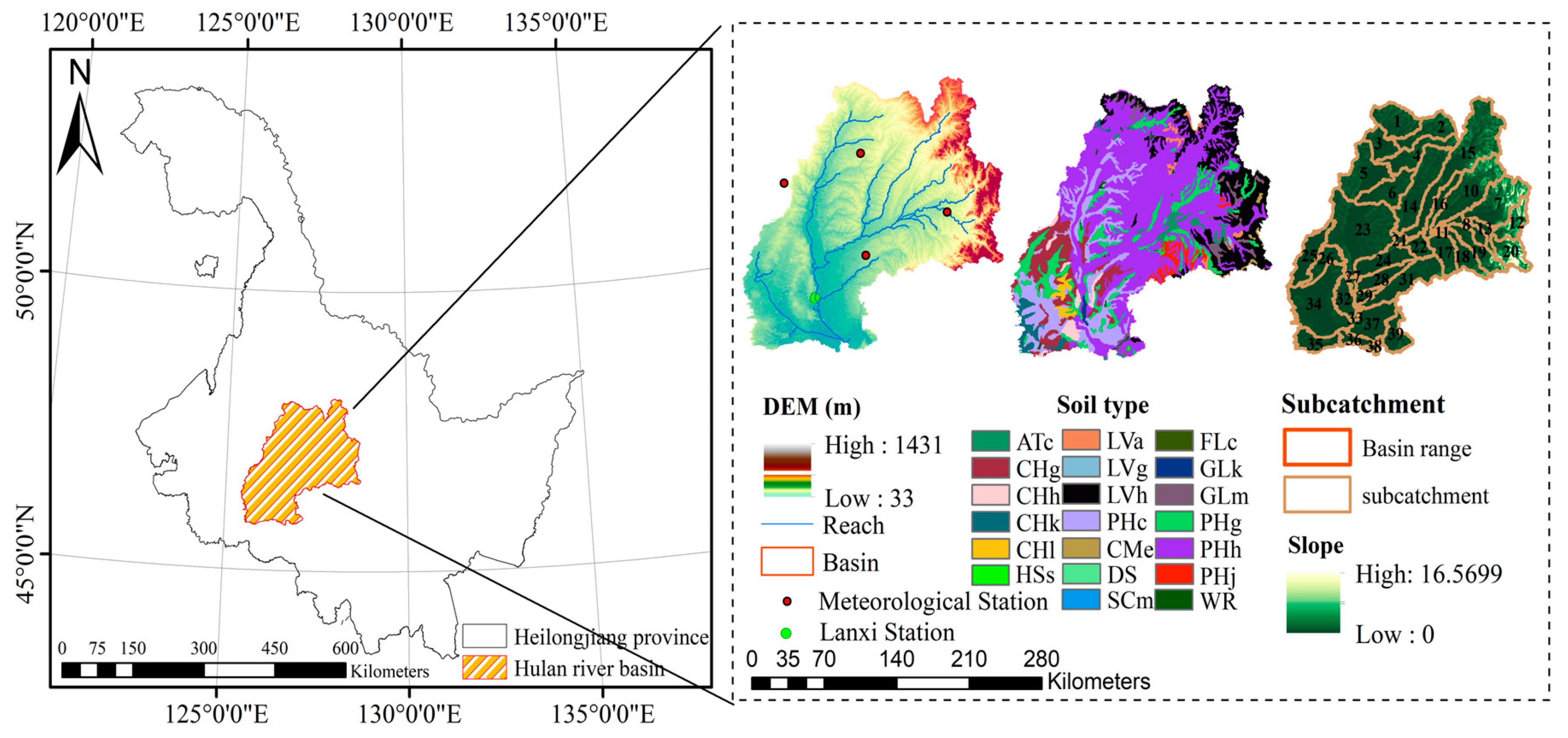
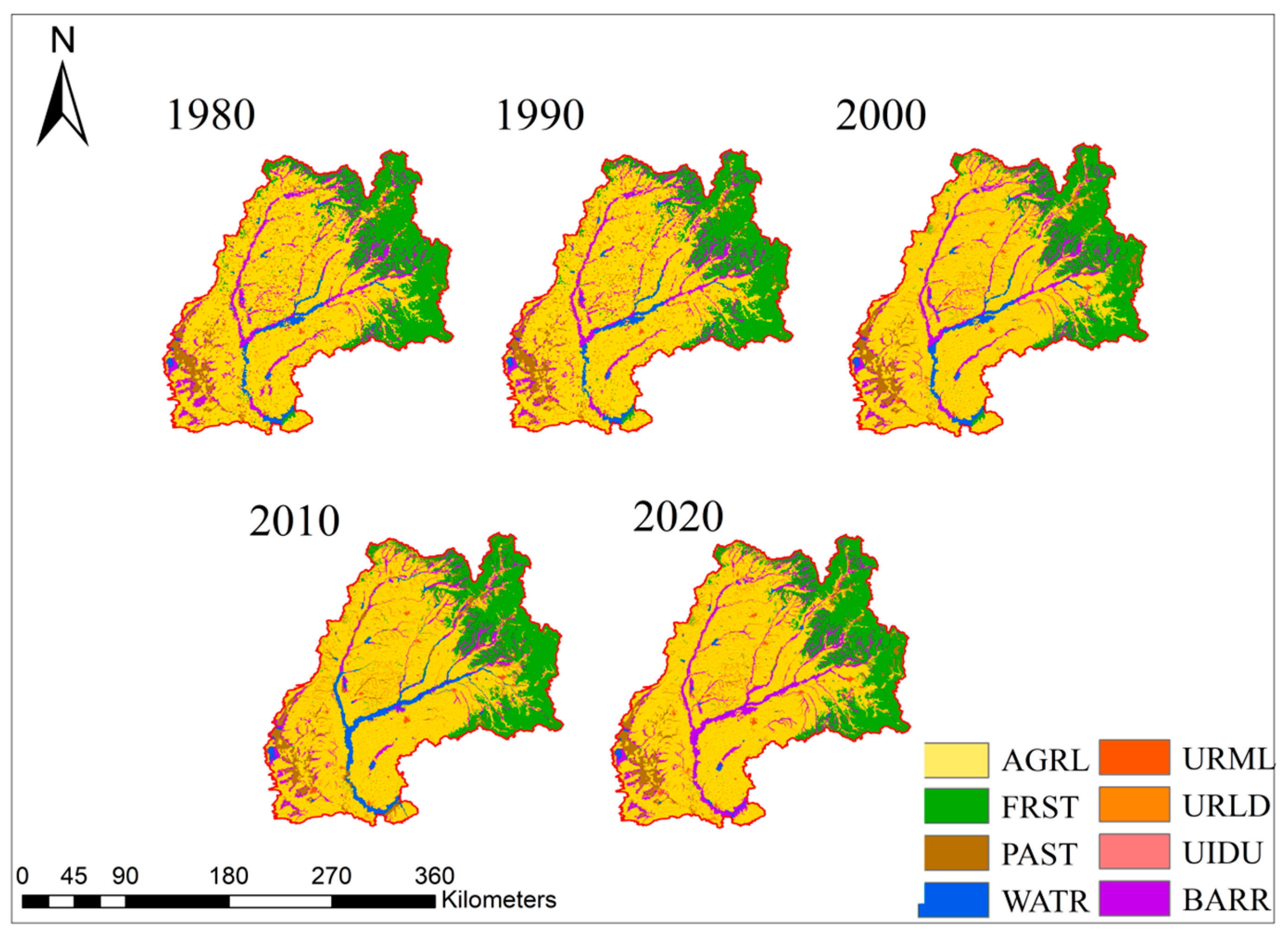
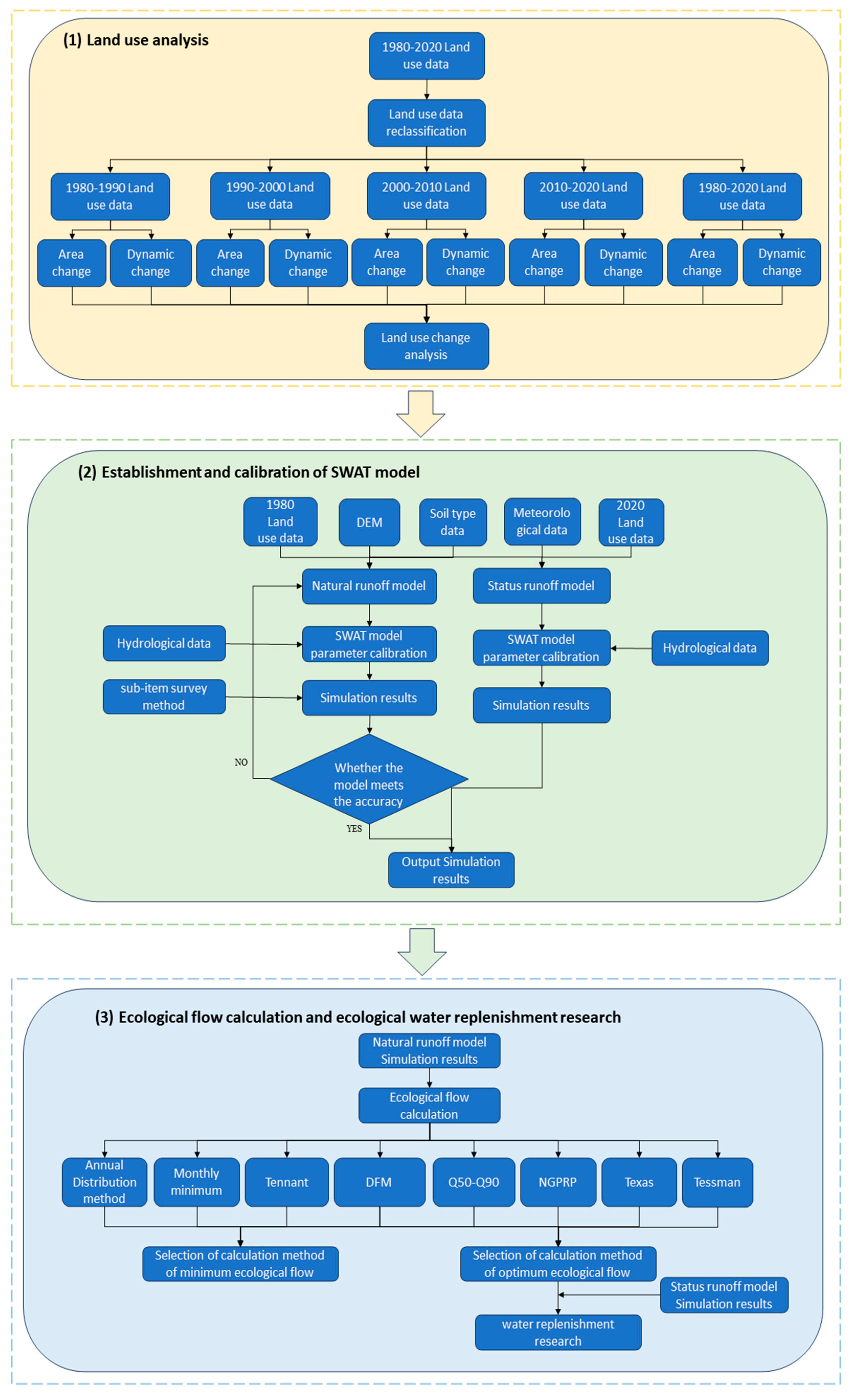

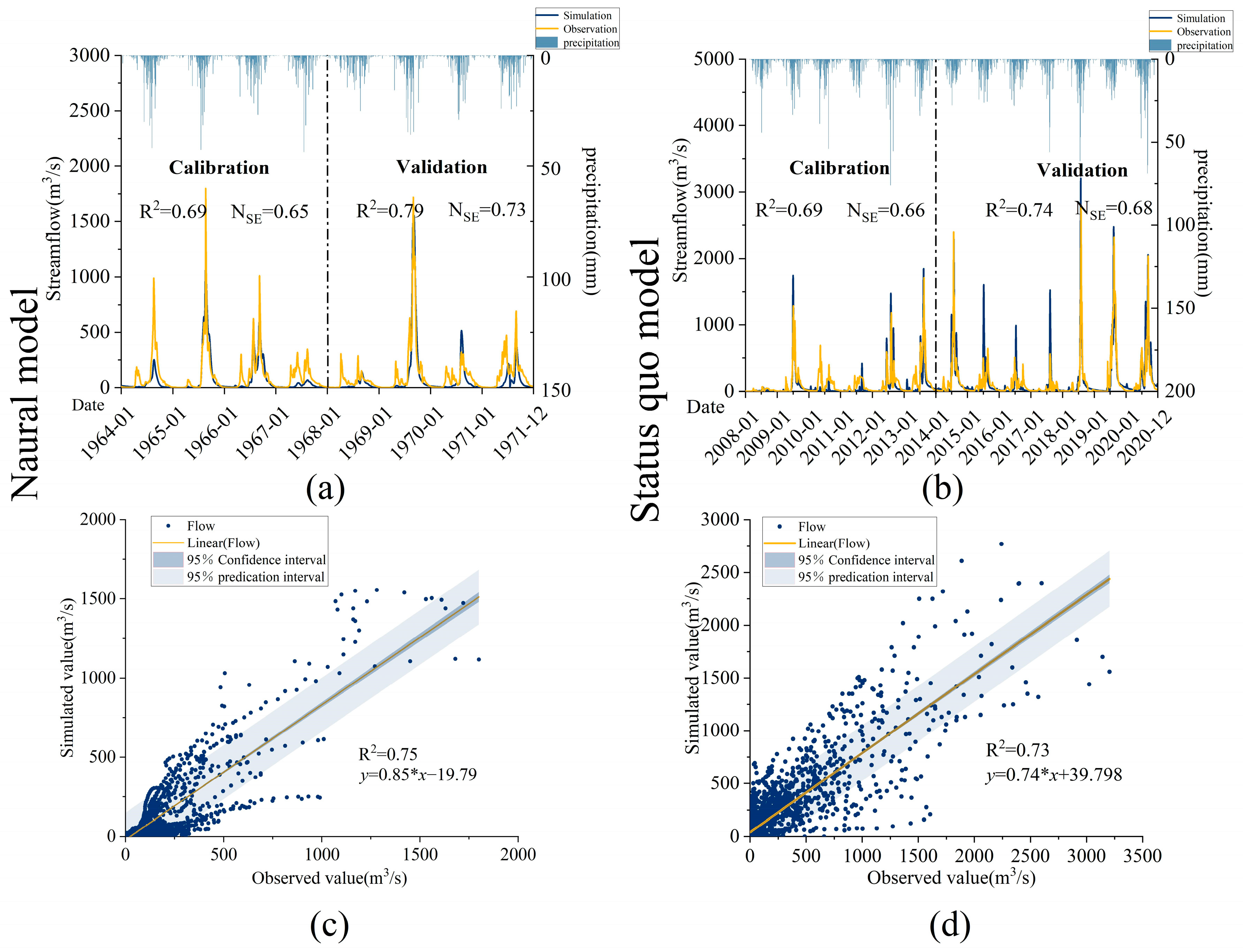
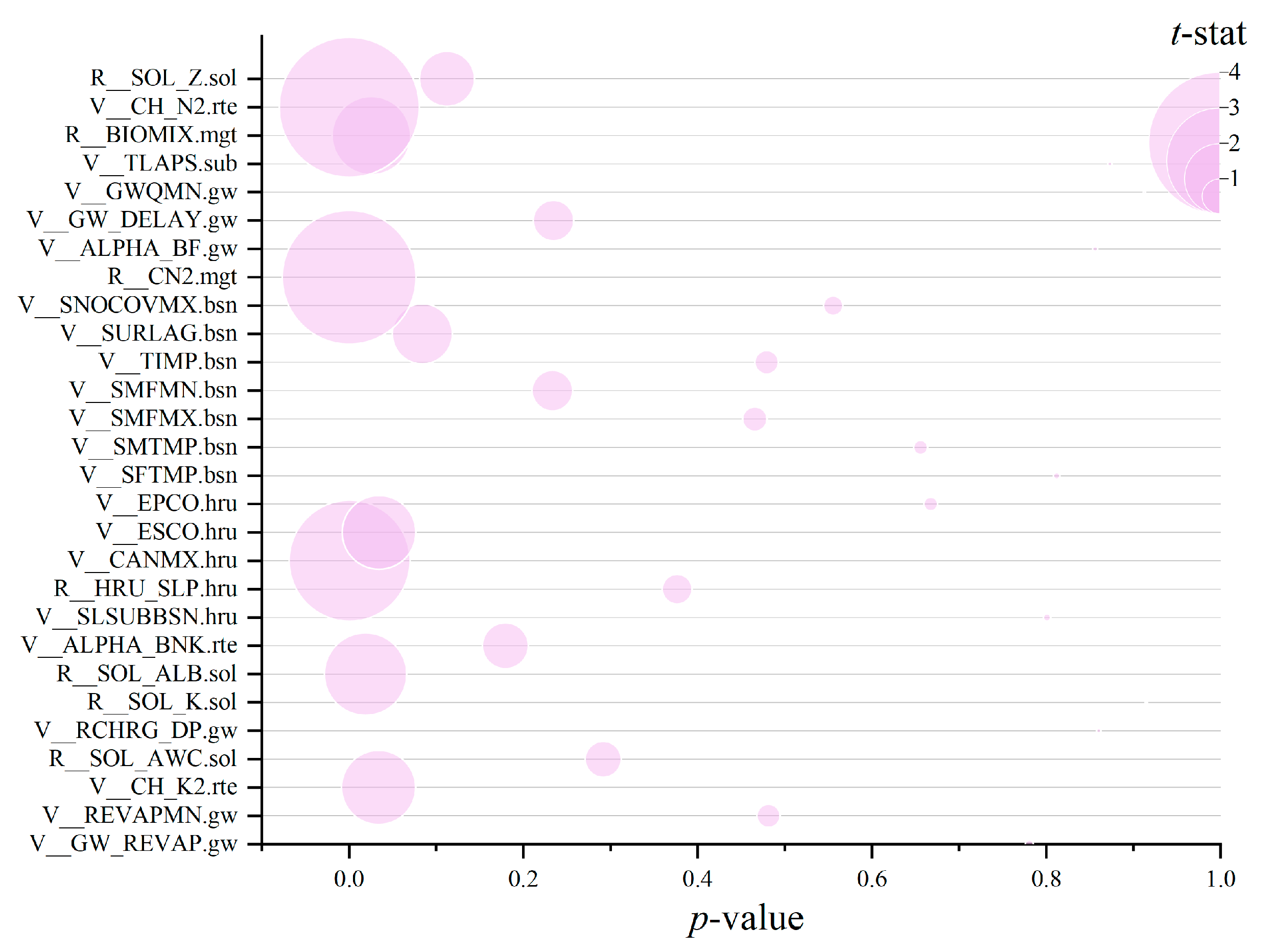

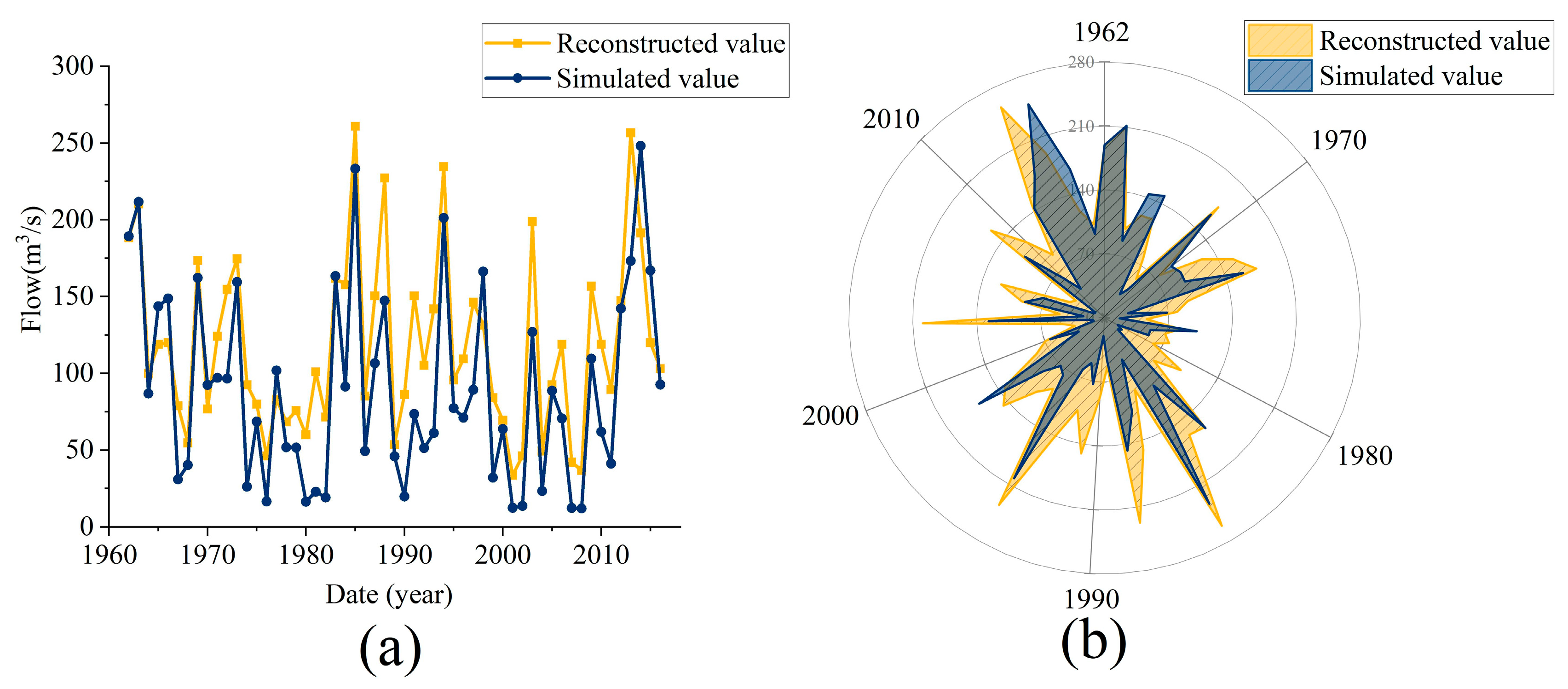
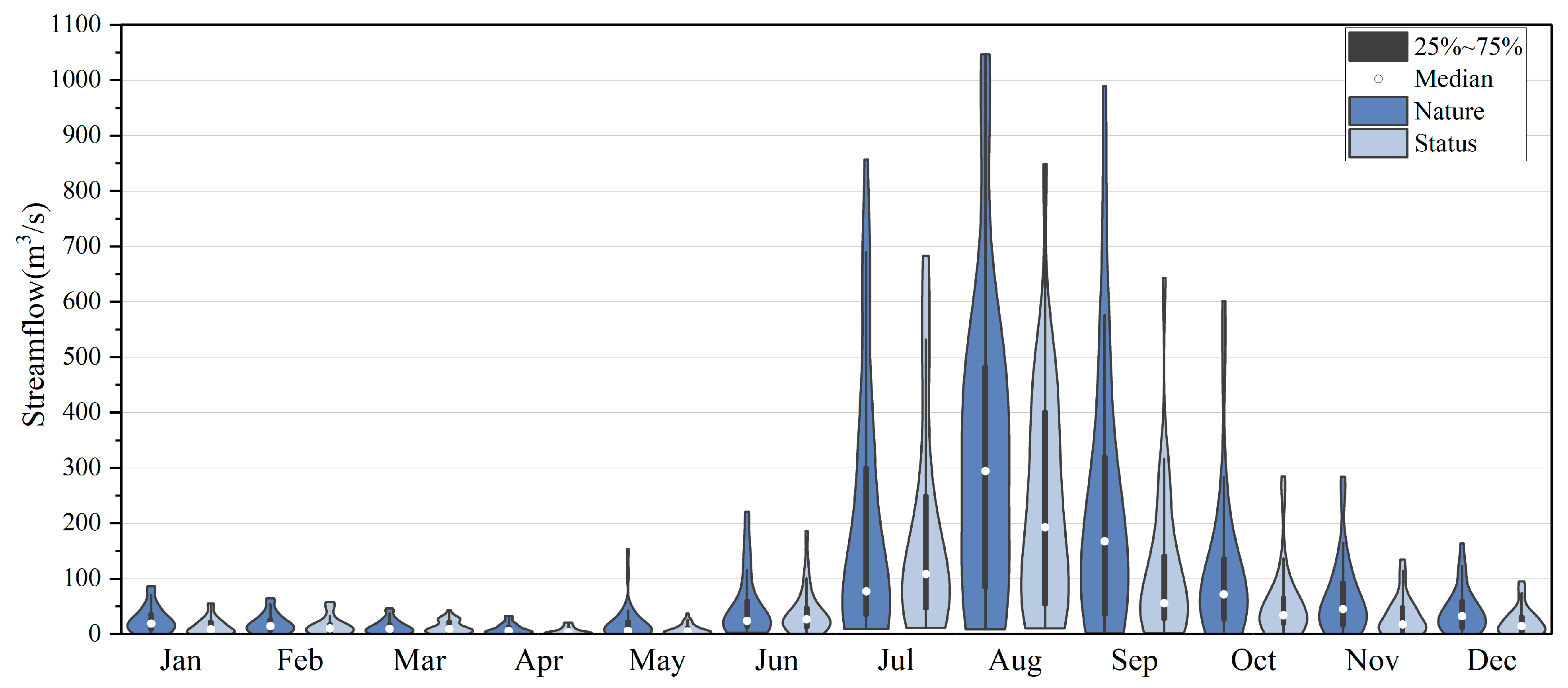
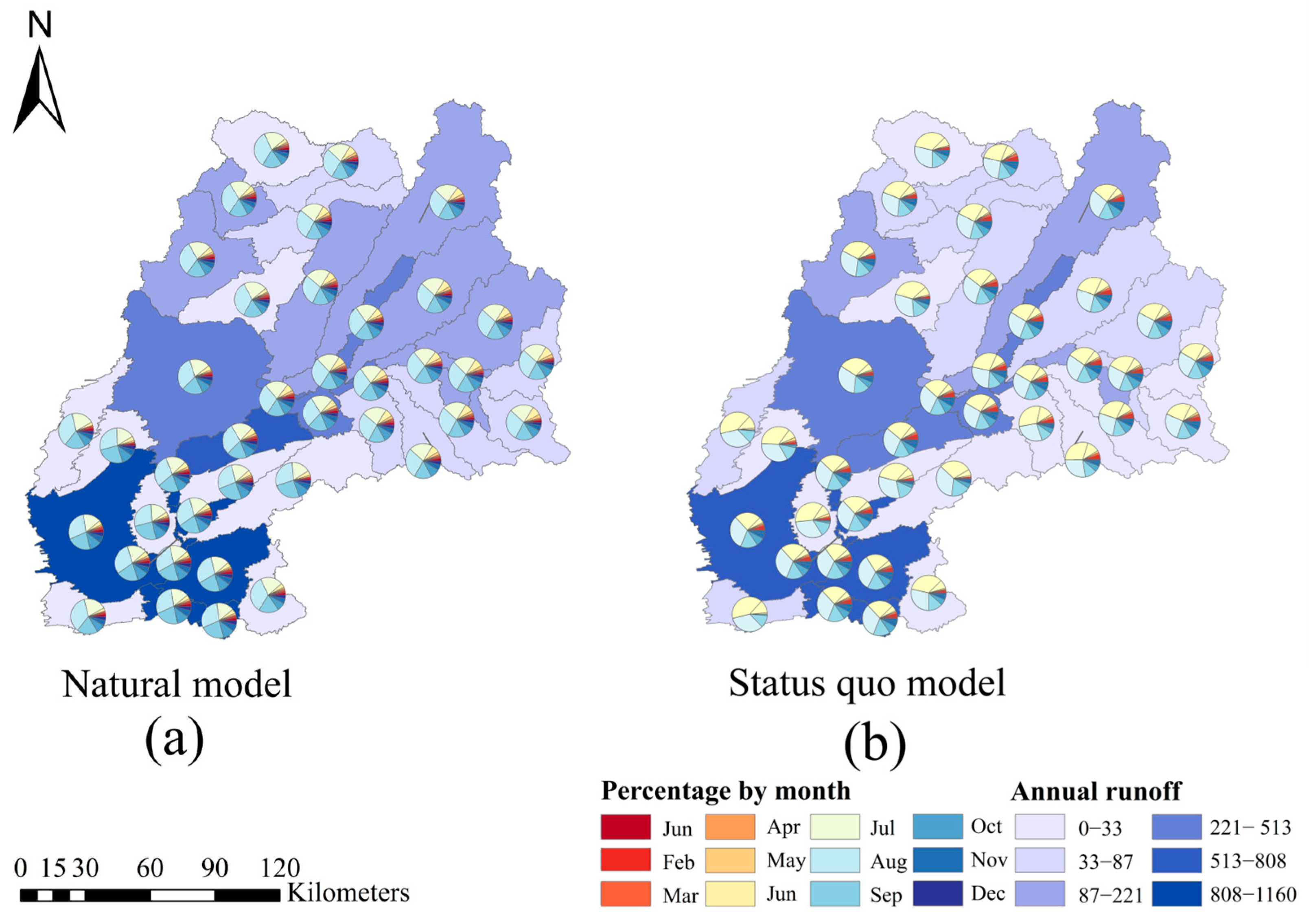
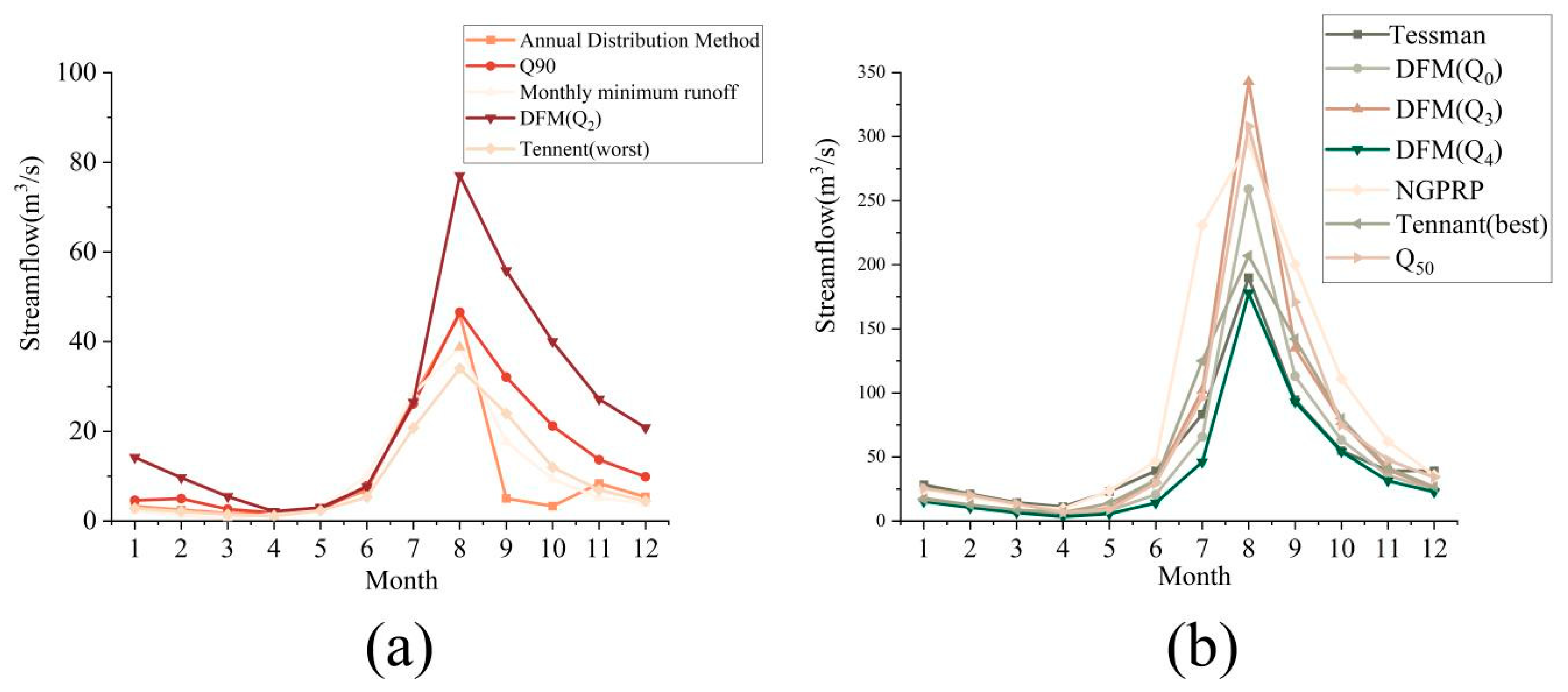
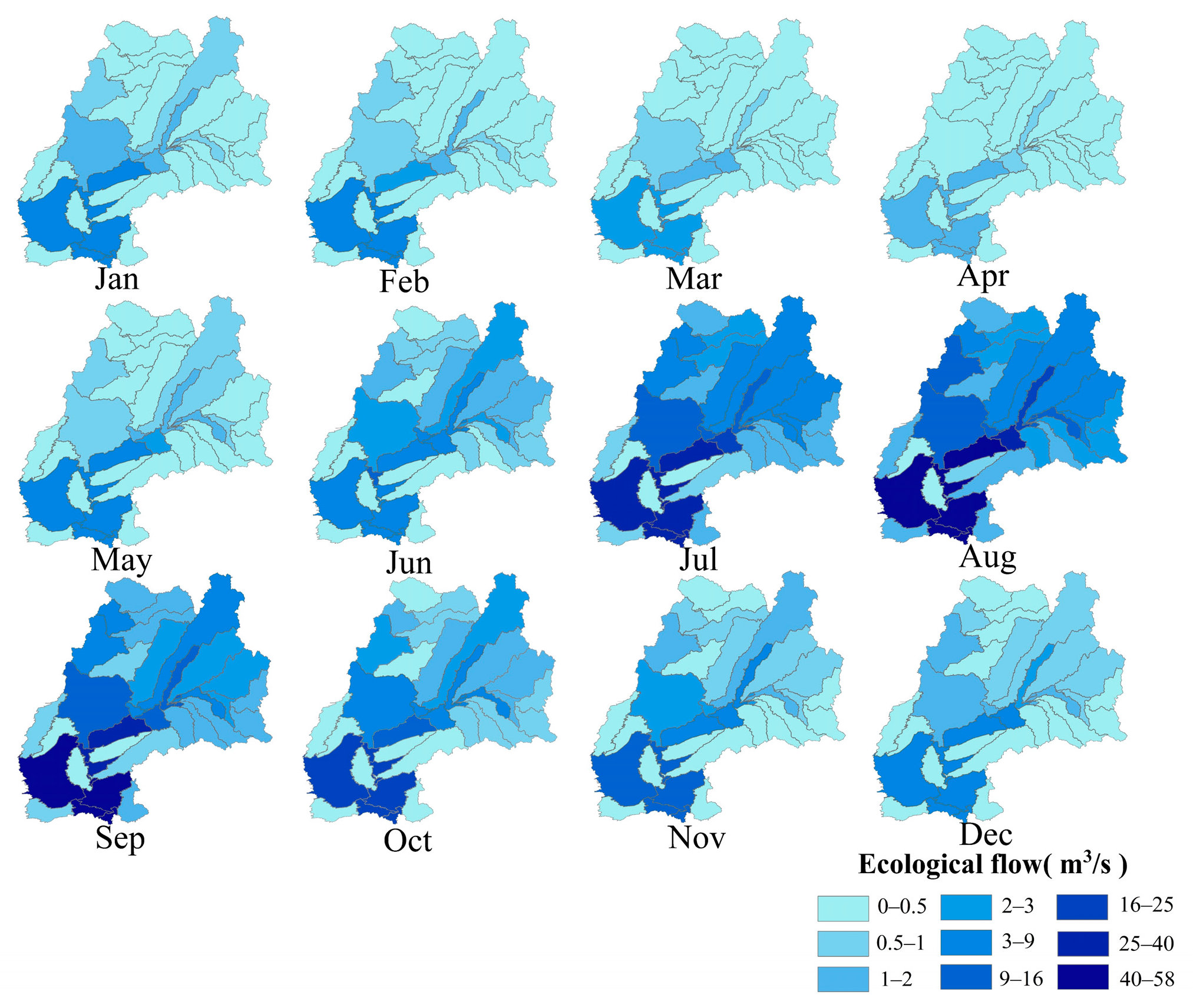
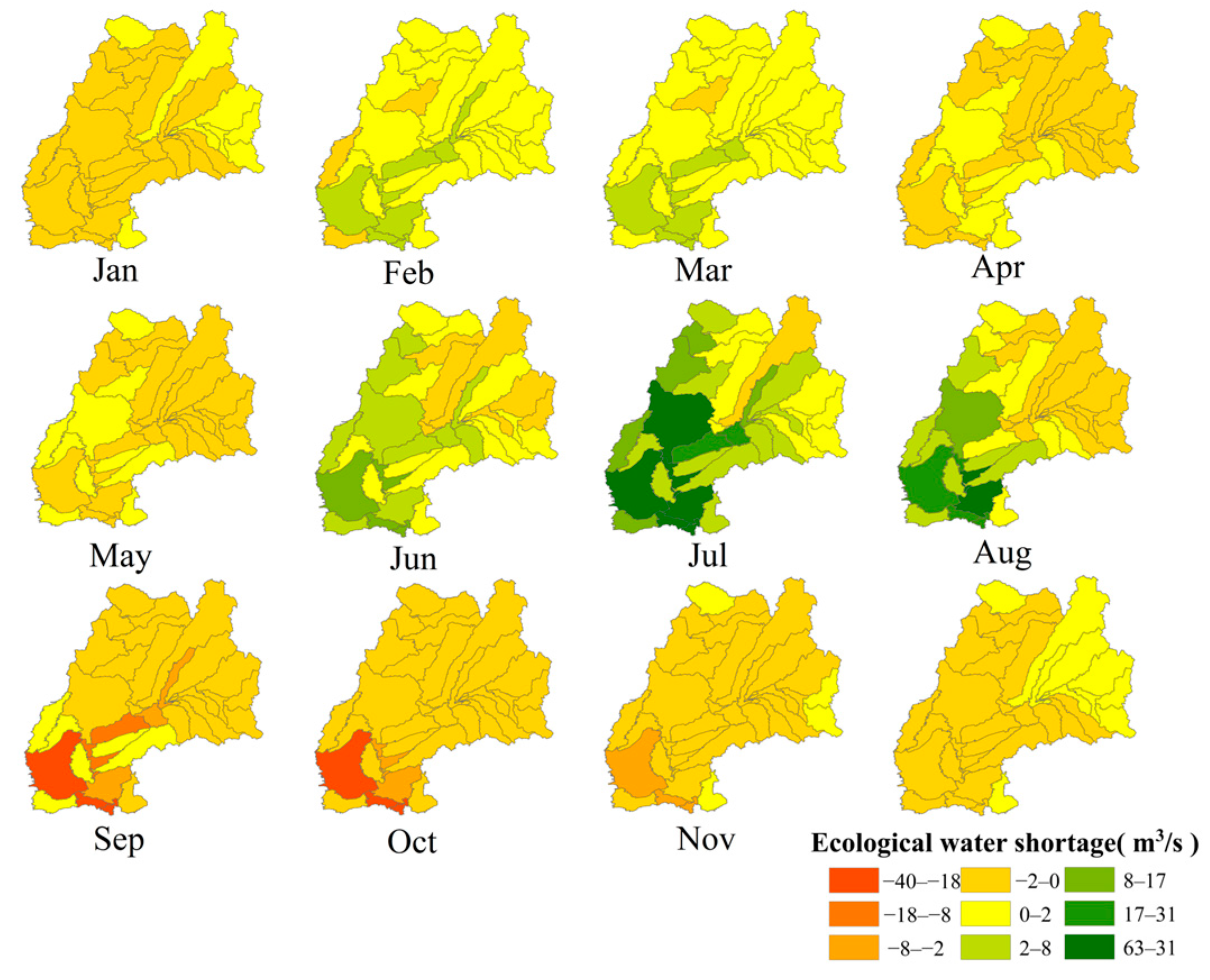
| Abbreviation | Land Use Category |
|---|---|
| AGRL | Agricultural Land |
| FRST | Forest |
| PAST | Pasture |
| WATR | Water Body |
| URML | Residential—Medium/Low Density |
| URLD | Residential—Low Density |
| UIDU | Industrial Land |
| BARR | Bare Land |
| Abbreviation | Soil Type | Abbreviation | Soil Type |
|---|---|---|---|
| ATc | Cumulic Anthrosols | CMe | Eutric Cambisols |
| CHg | Gleyic Chernozems | DS | Dunes and Shift Sands |
| CHh | Haplic Chernozems | SCm | Mollic Solonchaks |
| CHk | Calcic Chernozems | FLc | Calcaric Fluvisols |
| CHl | Luvic Chernozems | GLk | Calcic Gleysols |
| HSs | Terric Histosols | GLm | Mollic Gleysols |
| LVa | Albic Luvsiols | PHg | Gleyic Phaeozems |
| LVg | Gleyic Luvisols | PHh | Haplic Phaeozems |
| LVh | Haplic Luvisols | PHj | Stagnic Phaeozems |
| PHc | Calcaric Phaeozems | WR | Water Bodies |
| Parameters | Description of Calculation Method |
|---|---|
| Most optimal ecological flow (Q0) | Defined by the peak of the probability density function of monthly average flow within the hydrological sequence, forming the annual optimal ecological flow from monthly calculations. |
| Maximum ecological flow (Q1) | Determined by comparing the highest probability density functions of daily and monthly mean flows, selecting the smaller for each month to establish the annual maximum ecological flow. |
| Minimum ecological flow (Q2) | Established by comparing the highest probability density functions of daily and monthly minimum flows, selecting the larger for each month to form the annual minimum ecological flow. |
| Optimal upper threshold for ecological flow (Q3) | Calculated using the maximum and optimal ecological flow values to define the monthly and, subsequently, the annual upper threshold. |
| Optimal lower threshold for ecological flow (Q4) | Determined by averaging the minimum and optimal ecological flows for each month to establish the annual lower threshold. |
| Extremely large ecological flow (Q5) | Identified by the maximum daily flow in months with the highest ecological flow, forming the basis for the annual maximum ecological flow process. |
| Extremely small ecological flow (Q6) | Calculated from the minimum daily flows in months of minimum ecological flow, used to establish the annual minimum ecological flow process. |
| Ecological Condition State | Annual Natural Flow Percentages (%) | |
|---|---|---|
| Non-Flood Season | Flood Season | |
| Excellent | 60~100 | 60~100 |
| Very Good | 30 | 50 |
| Good | 20 | 40 |
| Medium | 10 | 30 |
| Bad | 10 | 10 |
| Land Use Type | 1980 | 1990 | 2000 | 2010 | 2020 | |||||
|---|---|---|---|---|---|---|---|---|---|---|
| Area (km2) | Percent (%) | Area (km2) | Percent (%) | Area (km2) | Percent (%) | Area (km2) | Percent (%) | Area (km2) | Percent (%) | |
| AGRL | 21,396.34 | 0.57 | 21,634.47 | 0.58 | 22,499.56 | 0.60 | 22105 | 0.59 | 22435 | 0.60 |
| FRST | 8774.81 | 0.23 | 8646.80 | 0.23 | 7846.85 | 0.21 | 8014.55 | 0.21 | 7766.47 | 0.21 |
| PAST | 1716.85 | 0.05 | 1669.26 | 0.04 | 1738.09 | 0.05 | 2216.57 | 0.06 | 1857.66 | 0.05 |
| WATR | 870.90 | 0.02 | 842.62 | 0.02 | 872.16 | 0.02 | 1421.72 | 0.04 | 1517.00 | 0.01 |
| URML | 119.71 | 0.00 | 135.78 | 0.00 | 151.10 | 0.00 | 185.64 | 0.00 | 179.32 | 0.00 |
| URLD | 1071.41 | 0.03 | 1122.16 | 0.03 | 1117.61 | 0.03 | 1249.19 | 0.03 | 1120.17 | 0.03 |
| UIDU | 3.99 | 0.00 | 2.00 | 0.00 | 3.08 | 0.00 | 14.88 | 0.00 | 37.66 | 0.00 |
| BARR | 3594.32 | 0.10 | 3495.26 | 0.09 | 3319.89 | 0.09 | 2340.78 | 0.06 | 2635.00 | 0.10 |
| Land Use Type | 1980–1990 | 1990–2000 | 2000–2010 | 2010–2020 | 1980–2020 | |||||
|---|---|---|---|---|---|---|---|---|---|---|
| Area Change (km2) | Single LUD Index (%) | Area Change (km2) | Single LUD Index (%) | Area Change (km2) | Single LUD Index (%) | Area Change (km2) | Single LUD Index (%) | Area Change (km2) | Single LUD Index (%) | |
| AGRL | 238.13 | 0.11 | 865.08 | 0.40 | −394.56 | −0.18 | 330.06 | 0.15 | 1038.72 | 0.49 |
| FRST | −128.01 | −0.15 | −799.95 | −0.93 | 167.70 | 0.21 | −248.08 | −0.31 | −1008.4 | −1.15 |
| PAST | −47.60 | −0.28 | 68.83 | 0.41 | 478.48 | 2.75 | −358.91 | −1.62 | 140.81 | 0.82 |
| WATR | −28.28 | −0.32 | 29.54 | 0.35 | 549.57 | 6.30 | 95.28 | −7.97 | 646.10 | −6.68 |
| URML | 16.07 | 1.34 | 15.33 | 1.13 | 34.54 | 2.29 | −6.32 | −0.34 | 59.61 | 4.98 |
| URLD | 50.74 | 0.47 | −4.55 | −0.04 | 131.58 | 1.18 | −129.03 | −1.03 | 48.75 | 0.46 |
| UIDU | −1.99 | −5.00 | 1.09 | 5.44 | 11.80 | 38.27 | 22.78 | 15.31 | 33.67 | 84.38 |
| BARR | −99.06 | −0.28 | −175.37 | −0.50 | −979.11 | −2.95 | 294.22 | 6.50 | −959.32 | 0.75 |
| CLUD Index (%) | 0.08 | 0.26 | 0.37 | 0.20 | 0.52 | |||||
| Parameter | Description | Parameter | Description |
|---|---|---|---|
| SOL_Z | Soil layer depth from surface to bottom | SFTMP | Snowfall temperature |
| CH_N2 | Manning’s “n” value for main flow channel | EPCO | Plant uptake compensation factor |
| BIOMIX | Biological mixing efficiency | ESCO | Soil evaporation compensation factor |
| TLAPS | Temperature lapse rate | CANMX | Maximum canopy storage |
| GWQMN | Minimum aquifer depth for groundwater return flow | HRU_SLP | Average slope steepness multiplicative factor |
| GW_DELAY | Groundwater delay time | SLSUBBSN | Average slope length multiplicative factor |
| ALPHA_BF | Baseflow alpha factor | ALPHA_BNK | Alpha factor for bank storage baseflow |
| CN2 | SCS-CN for moisture condition II | SOL_ALB | Moist soil albedo multiplicative factor |
| SNOCOVMX | Threshold depth of snow at 100% coverage | SOL_K | Soil hydraulic conductivity |
| SURLAG | Surface runoff lag coefficient | RCHRG_DP | Deep aquifer percolation fraction |
| TIMP | Snow pack temperature lag factor | SOL_AWC | Soil available water capacity |
| SMFMN | Maximum snowmelt factor for December 21 | CH_K2 | Effective hydraulic conductivity in main channel alluvium |
| SMFMX | Maximum snowmelt factor for June 21 | REVAPMN | Threshold depth of water in shallow aquifer required to allow re-evaporation to occur |
| SMTMP | Snowmelt base temperature | GW_REVAP | Groundwater re-evaporation coefficient |
| Method | Month | |||||||||||
|---|---|---|---|---|---|---|---|---|---|---|---|---|
| 1 | 2 | 3 | 4 | 5 | 6 | 7 | 8 | 9 | 10 | 11 | 12 | |
| Distribution | 3.32 | 2.53 | 1.71 | 1.39 | 2.97 | 6.91 | 27.6 | 46. | 5.05 | 3.34 | 8.37 | 5.39 |
| Monthly Minimum | 2.22 | 1.39 | 0.41 | 1.67 | 2.98 | 10.1 | 28.4 | 38.7 | 17.7 | 9.38 | 5.19 | 3.94 |
| Texas | 7.65 | 6.05 | 4.08 | 2.06 | 2.68 | 8.85 | 28.9 | 92.4 | 51.4 | 22.4 | 14.3 | 10.3 |
| Q50 | 25.5 | 20.2 | 13.6 | 6.87 | 8.92 | 29.5 | 96.3 | 308 | 171 | 75 | 47.6 | 34.2 |
| Q75 | 12.6 | 10 | 5.99 | 2.80 | 4.69 | 13.6 | 33.5 | 87.4 | 39 | 33.4 | 19.1 | 13.7 |
| Q90 | 4.62 | 5.02 | 2.66 | 1.80 | 2.56 | 7.83 | 26.1 | 46.6 | 32. | 21.2 | 13.7 | 9.89 |
| Tessman | 28.3 | 21.2 | 14.5 | 11.2 | 23.2 | 39.2 | 83.3 | 138 | 94.7 | 48 | 39.2 | 39.2 |
| DFM (Q0) | 16.5 | 11.4 | 7.63 | 4.78 | 8.36 | 20.7 | 65.8 | 259 | 113 | 63.3 | 35.6 | 24.7 |
| DFM (Q1) | 19.2 | 14 | 9.55 | 6.53 | 12 | 43.7 | 138 | 428 | 156 | 91.7 | 44.1 | 26.9 |
| DFM (Q2) | 14.2 | 9.68 | 5.47 | 2.14 | 3.03 | 7.65 | 26.5 | 97 | 74 | 45 | 27.2 | 20.8 |
| DFM (Q3) | 17.8 | 12.7 | 8.59 | 5.66 | 10.2 | 32.2 | 102 | 343 | 135 | 77.5 | 39.8 | 25.8 |
| DFM (Q4) | 15.3 | 10.6 | 6.55 | 3.46 | 5.69 | 14.2 | 46.2 | 178 | 93 | 54.2 | 31.4 | 22.7 |
| DFM (Q5) | 99.5 | 71.4 | 53 | 37.5 | 329 | 530 | 1208 | 1421 | 1251 | 846 | 430. | 199 |
| DFM (Q6) | 0.00 | 0.00 | 0.00 | 0.00 | 0.00 | 0.00 | 1.02 | 2.07 | 0.00 | 0.00 | 0.00 | 0.00 |
| NGPRP | 24.7 | 18.8 | 12.4 | 9.63 | 23.7 | 46.8 | 231 | 295 | 200 | 111 | 62.1 | 35.9 |
| Tennant (Excellent) | 17 | 12.7 | 8.67 | 6.70 | 13.9 | 31.9 | 125 | 207 | 142 | 80 | 41.5 | 26.6 |
| Tennant (Very Good) | 8.5 | 6.37 | 4.34 | 3.35 | 6.95 | 26.6 | 104 | 172 | 118 | 60 | 20.8 | 13.3 |
| Tennant (Good) | 5.67 | 4.25 | 2.89 | 2.23 | 4.64 | 21.3 | 83 | 138 | 95 | 48 | 13.8 | 8.87 |
| Tennant (Medium) | 2.83 | 2 | 1.45 | 1.12 | 2.32 | 15.9 | 62.5 | 103 | 71 | 36 | 6.92 | 4.43 |
| Tennant (Bad) | 2.83 | 2 | 1.45 | 1.12 | 2.32 | 5.31 | 20.8 | 34 | 24 | 12 | 6.92 | 4.43 |
Disclaimer/Publisher’s Note: The statements, opinions and data contained in all publications are solely those of the individual author(s) and contributor(s) and not of MDPI and/or the editor(s). MDPI and/or the editor(s) disclaim responsibility for any injury to people or property resulting from any ideas, methods, instructions or products referred to in the content. |
© 2024 by the authors. Licensee MDPI, Basel, Switzerland. This article is an open access article distributed under the terms and conditions of the Creative Commons Attribution (CC BY) license (https://creativecommons.org/licenses/by/4.0/).
Share and Cite
Liu, G.-W.; Dai, C.-L.; Shao, Z.-X.; Xiao, R.-H.; Guo, H.-C. Assessment of Ecological Flow in Hulan River Basin Utilizing SWAT Model and Diverse Hydrological Approaches. Sustainability 2024, 16, 2513. https://doi.org/10.3390/su16062513
Liu G-W, Dai C-L, Shao Z-X, Xiao R-H, Guo H-C. Assessment of Ecological Flow in Hulan River Basin Utilizing SWAT Model and Diverse Hydrological Approaches. Sustainability. 2024; 16(6):2513. https://doi.org/10.3390/su16062513
Chicago/Turabian StyleLiu, Geng-Wei, Chang-Lei Dai, Ze-Xuan Shao, Rui-Han Xiao, and Hong-Cong Guo. 2024. "Assessment of Ecological Flow in Hulan River Basin Utilizing SWAT Model and Diverse Hydrological Approaches" Sustainability 16, no. 6: 2513. https://doi.org/10.3390/su16062513
APA StyleLiu, G.-W., Dai, C.-L., Shao, Z.-X., Xiao, R.-H., & Guo, H.-C. (2024). Assessment of Ecological Flow in Hulan River Basin Utilizing SWAT Model and Diverse Hydrological Approaches. Sustainability, 16(6), 2513. https://doi.org/10.3390/su16062513






